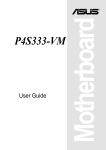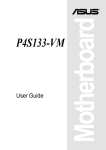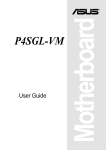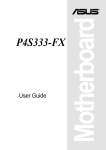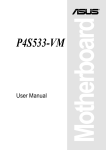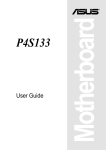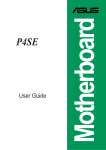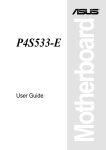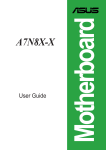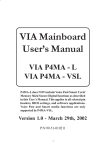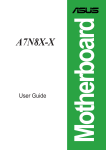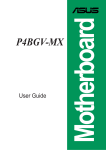Download Asus P4SDR-VM User guide
Transcript
User Guide Motherboard P4SDR-VM E1104 Checklist First Edition August 2002 Copyright © 2002 ASUSTeK COMPUTER INC. All Rights Reserved. No part of this manual, including the products and software described in it, may be reproduced, transmitted, transcribed, stored in a retrieval system, or translated into any language in any form or by any means, except documentation kept by the purchaser for backup purposes, without the express written permission of ASUSTeK COMPUTER INC. (“ASUS”). Product warranty or service will not be extended if: (1) the product is repaired, modified or altered, unless such repair, modification of alteration is authorized in writing by ASUS; or (2) the serial number of the product is defaced or missing. ASUS PROVIDES THIS MANUAL “AS IS” WITHOUT WARRANTY OF ANY KIND, EITHER EXPRESS OR IMPLIED, INCLUDING BUT NOT LIMITED TO THE IMPLIED WARRANTIES OR CONDITIONS OF MERCHANTABILITY OR FITNESS FOR A PARTICULAR PURPOSE. IN NO EVENT SHALL ASUS, ITS DIRECTORS, OFFICERS, EMPLOYEES OR AGENTS BE LIABLE FOR ANY INDIRECT, SPECIAL, INCIDENTAL, OR CONSEQUENTIAL DAMAGES (INCLUDING DAMAGES FOR LOSS OF PROFITS, LOSS OF BUSINESS, LOSS OF USE OR DATA, INTERRUPTION OF BUSINESS AND THE LIKE), EVEN IF ASUS HAS BEEN ADVISED OF THE POSSIBILITY OF SUCH DAMAGES ARISING FROM ANY DEFECT OR ERROR IN THIS MANUAL OR PRODUCT. SPECIFICATIONS AND INFORMATION CONTAINED IN THIS MANUAL ARE FURNISHED FOR INFORMATIONAL USE ONLY, AND ARE SUBJECT TO CHANGE AT ANY TIME WITHOUT NOTICE, AND SHOULD NOT BE CONSTRUED AS A COMMITMENT BY ASUS. ASUS ASSUMES NO RESPONSIBILITY OR LIABILITY FOR ANY ERRORS OR INACCURACIES THAT MAY APPEAR IN THIS MANUAL, INCLUDING THE PRODUCTS AND SOFTWARE DESCRIBED IN IT. Products and corporate names appearing in this manual may or may not be registered trademarks or copyrights of their respective companies, and are used only for identification or explanation and to the owners’ benefit, without intent to infringe. ii Contents Features Contents ......................................................................................... iii Notices ............................................................................................ v Safety information .......................................................................... vi About this guide ............................................................................. vii ASUS contact information ............................................................ viii P4SDR-VM specifications summary .............................................. ix Chapter 1: Product introduction 1.1 1.2 1.3 1.4 Welcome! ........................................................................... 1-1 Package contents ............................................................... 1-1 Special features .................................................................. 1-2 1.3.1 Product highlights .................................................. 1-2 1.3.2 Value-added solutions ............................................ 1-3 Motherboard overview ........................................................ 1-4 1.4.1 Major components ................................................. 1-4 1.4.2 Core specifications ................................................ 1-6 Chapter 2: Hardware information 2.1 2.2 2.3 2.4 2.5 2.6 2.7 2.8 Motherboard installation ..................................................... 2-1 2.1.1 Placement direction ............................................... 2-1 2.1.2 Screw holes ........................................................... 2-1 Motherboard layout ............................................................ 2-2 Before you proceed ............................................................ 2-3 Central Processing Unit (CPU) ........................................... 2-4 2.4.1 Overview ................................................................ 2-4 2.4.2 Installing the CPU .................................................. 2-5 2.4.3 Installing the heatsink and fan ............................... 2-7 2.4.4 Connecting the CPU fan cable .............................. 2-9 System memory ............................................................... 2-10 2.5.1 Overview .............................................................. 2-10 2.5.2 Memory configurations ........................................ 2-10 2.5.3 Installing a DIMM ..................................................2-11 2.5.4 Removing a DIMM ................................................2-11 Expansion slots ...............................................................2-112 2.6.1 Installing an expansion card ................................ 2-12 2.6.2 Configuring an expansion card ............................ 2-12 2.6.3 PCI slots .............................................................. 2-13 Jumpers ............................................................................ 2-14 Connectors ....................................................................... 2-18 iii Contents Safeguards Chapter 3: Powering up 3.1 3.2 Starting up for the first time ................................................ 3-1 Powering off the computer ................................................. 3-2 Chapter 4: BIOS setup 4.1 4.2 4.3 4.4 4.5 4.6 4.7 Managing and updating your BIOS .................................... 4-1 4.1.1 Using the computer for the first time ...................... 4-1 4.1.2 Updating the BIOS ................................................. 4-3 BIOS Setup program .......................................................... 4-5 4.2.1 BIOS menu bar ...................................................... 4-6 4.2.2 Legend bar ............................................................. 4-6 Main Menu .......................................................................... 4-8 4.3.1 Primary and Secondary Master/Slave ................. 4-10 4.3.2 Keyboard Features .............................................. 4-14 Advanced Menu ............................................................... 4-15 4.4.1 Chip Configuration ............................................... 4-17 4.4.2 I/O Device Configuration ...................................... 4-19 4.4.3 PCI Configuration ................................................ 4-21 Power Menu ..................................................................... 4-24 4.5.1 Power Up Control ................................................ 4-26 4.5.2 Hardware Monitor ................................................ 4-28 Boot Menu ........................................................................ 4-29 Exit Menu ......................................................................... 4-31 Chapter 5: Software support 5.1 5.2 5.3 Install an operating system ................................................. 5-1 Support CD information ...................................................... 5-1 5.2.1 Running the support CD ........................................ 5-1 5.2.2 Installation menus .................................................. 5-2 5.2.3 Software and drivers description ........................... 5-3 Software information .......................................................... 5-5 5.3.1 ASUS Update ........................................................ 5-5 5.3.2 ASUS PC Probe .................................................... 5-7 5.3.3 E-Color 3Deep ..................................................... 5-12 Index ........................................................................................ I-1 iv Notices Federal Communications Commission Statement This device complies with FCC Rules Part 15. Operation is subject to the following two conditions: • This device may not cause harmful interference, and • This device must accept any interference received including interference that may cause undesired operation. This equipment has been tested and found to comply with the limits for a Class B digital device, pursuant to Part 15 of the FCC Rules. These limits are designed to provide reasonable protection against harmful interference in a residential installation. This equipment generates, uses and can radiate radio frequency energy and, if not installed and used in accordance with manufacturer’s instructions, may cause harmful interference to radio communications. However, there is no guarantee that interference will not occur in a particular installation. If this equipment does cause harmful interference to radio or television reception, which can be determined by turning the equipment off and on, the user is encouraged to try to correct the interference by one or more of the following measures: • Reorient or relocate the receiving antenna. • Increase the separation between the equipment and receiver. • Connect the equipment to an outlet on a circuit different from that to which the receiver is connected. • Consult the dealer or an experienced radio/TV technician for help. The use of shielded cables for connection of the monitor to the graphics card is required to assure compliance with FCC regulations. Changes or modifications to this unit not expressly approved by the party responsible for compliance could void the user’s authority to operate this equipment. Canadian Department of Communications Statement This digital apparatus does not exceed the Class B limits for radio noise emissions from digital apparatus set out in the Radio Interference Regulations of the Canadian Department of Communications. This class B digital apparatus complies with Canadian ICES-003. v Safety information Electrical safety • To prevent electrical shock hazard, disconnect the power cable from the electrical outlet before relocating the system. • When adding or removing devices to or from the system, ensure that the power cables for the devices are unplugged before the signal cables are connected. If possible, disconnect all power cables from the existing system before you add a device. • Before connecting or removing signal cables from the motherboard, ensure that all power cables are unplugged. • Seek professional assistance before using an adpater or extension cord. These devices could interrupt the grounding circuit. • Make sure that your power supply is set to the correct voltage in your area. If you are not sure about the voltage of the electrical outlet you are using, contact your local power company. • If the power supply is broken, do not try to fix it by yourself. Contact a qualified service technician or your retailer. Operation safety • Before installing the motherboard and adding devices on it, carefully read all the manuals that came with the package. • Before using the product, make sure all cables are correctly connected and the power cables are not damaged. If you detect any damage, contact your dealer immediately. • To avoid short circuits, keep paper clips, screws, and staples away from connectors, slots, sockets and circuitry. • Avoid dust, humidity, and temperature extremes. Do not place the product in any area where it may become wet. • Place the product on a stable surface. • If you encounter technical problems with the product, contact a qualified service technician or your retailer. vi About this guide This user guide contains the information you need when installing the ASUS P4SDR-VM motherboard. How this guide is organized This manual contains the following parts: • Chapter 1: Product introduction This chapter describes the features of the P4SDR-VM motherboard. It includes brief descriptions of the special attributes of the motherboard and the new technology it supports. • Chapter 2: Hardware information This chapter lists the hardware setup procedures that you have to perform when installing system components. It includes description of the switches, jumpers, and connectors on the motherboard. • Chapter 3: Powering up This chapter describes the power up sequence and gives information on the BIOS beep codes. • Chapter 4: BIOS setup This chapter tells how to change system settings through the BIOS Setup menus. Detailed descriptions of the BIOS parameters are also provided. • Chapter 5: Software support This chapter describes the contents of the support CD that comes with the motherboard package. • Index This part contains an alphabetical list of the topics found in this document. Conventions used in this guide To make sure that you perform certain tasks properly, take note of the following symbols used throughout this manual. WARNING: Information to prevent injury to yourself when trying to complete a task. CAUTION: Information to prevent damage to the components when trying to complete a task. IMPORTANT: Information that you MUST follow to complete a task. NOTE: Tips and additional information to aid in completing a task. vii ASUS contact information ASUSTeK COMPUTER INC. (Asia-Pacific) Address: General Tel: General Fax: General Email: 150 Li-Te Road, Peitou, Taipei, Taiwan 112 +886-2-2894-3447 +886-2-2894-3449 [email protected] Technical Support MB/Others (Tel): Notebook (Tel): Desktop/Server (Tel): Support Fax: Support Email: Web Site: Newsgroup: +886-2-2890-7121 (English) +886-2-2890-7122 (English) +886-2-2890-7123 (English) +886-2-2890-7698 [email protected] www.asus.com.tw cscnews.asus.com.tw ASUS COMPUTER INTERNATIONAL (America) Address: General Fax: General Email: 6737 Mowry Avenue, Mowry Business Center, Building 2, Newark, CA 94560, USA +1-510-608-4555 [email protected] Technical Support Support Fax: General Support: Web Site: Support Email: +1-510-608-4555 +1-502-995-0883 www.asus.com [email protected] ASUS COMPUTER GmbH (Europe) Address: General Fax: General Email: Harkortstr. 25, 40880 Ratingen, BRD, Germany +49-2102-442066 [email protected] (for marketing requests only) Technical Support Support Hotline: Notebook (Tel): Support Fax: Support (Email): Web Site: viii MB/Others: +49-2102-9599-0 +49-2102-9599-10 +49-2102-9599-11 www.asuscom.de/de/support (for online support) www.asuscom.de P4SDR-VM specifications summary CPU Socket 478 for Intel® Pentium® 4 On-die 512KB/256KB L2 cache Chipset SiS650GL Host Memory Controller SiS961B0 MuTIOL Media I/O Front Side Bus (FSB) 100 MHz Memory 2 x 168-pin DIMM sockets for up to 2GB system memory Supports unbuffered non-ECC PC100/PC133 DIMMs Expansion slots 3 x PCI IDE 2 x UltraDMA 133/100/66/33 Audio (optional) Realtek ALC201A AC’97 audio CODEC Special features ASUS JumperFree™ mode Adjustable CPU, PCI, and memory frequency ratios STR (Suspend-to-RAM) SFS (Stepless Frequency Selection) Temperature, fan, and CPU voltage monitoring Rear panel I/O 1 x Parallel port 1 x Serial port 1 x VGA port 1 x PS/2 keyboard port 1 x PS/2 mouse port 2 x USB 1.1 ports Line In/Line Out/Microphone ports (optional) Internal I/O 2 x USB 1.1 connectors for 4 additional USB ports CPU/Chassis fan connectors 20-pin/4-pin ATX power connectors IDE LED/Standby power LED connectors SIR connector (optional) S/PDIF Out connector (optional) CD/AUX/Modem audio connectors (optional) BIOS features 2Mb Flash ROM, Award BIOS with ACPI, PnP, DMI2.0, Green, and Trend Chip Away Virus (TCAV) features Industry standard PCI 2.2, USB 1.1 Manageability DMI 2.0, WOL/WOR by PME Form Factor ATX form factor: 9.6 in x 7.5 in (24.5 cm x 19 cm) Support CD contents Device drivers ASUS PC Probe ASUS Update Software applications ix x Chapter 1 This chapter describes the features of the P4SDR-VM motherboard. It includes brief explanations of the special attributes of the motherboard and the new technology it supports. Product introduction Chapter summary 1.1 Welcome! ........................................................ 1-1 1.2 Package contents .......................................... 1-1 1.3 Special features ............................................. 1-2 1.4 Motherboard overview ................................... 1-4 ASUS P4SDR-VM motherboard 1.1 Welcome! Thank you for buying the ASUS® P4SDR-VM motherboard! The ASUS P4SDR-VM motherboard delivers a host of new features and latest technologies making it another standout in the long line of ASUS quality motherboards! The P4SDR-VM incorporates the Intel® Pentium® 4 Processor in 478-pin package coupled with the SiS SIS650GL chipset to deliver a cost-effective desktop platform solution. Supporting up to 2GB of system memory with PC133/100 SDRAM, highspeed data transfers using the ATA133 protocol, and PCI audio features, the P4SDR-VM has enough features for your computing needs. Before you start installing the motherboard, and hardware devices on it, check the items in your package with the list below. 1.2 Package contents Check your P4SDR-VM package for the following items. ASUS P4SDR-VM motherboard Micro-ATX form factor: 9.6 in x 7.5 in (24.5 cm x 19 cm) ASUS P4SDR-VM series support CD 80-conductor Ultra ATA/133/100/66 IDE ribbon cable 40-conductor IDE cable Ribbon cable for a 3.5-inch floppy drive Bag of extra jumper caps User Guide If any of the above items is damaged or missing, contact your retailer. ASUS P4SDR-VM motherboard user guide 1-1 1.3 Special features 1.3.1 Product highlights Latest processor technology The P4SDR-VM motherboard supports the latest Intel® Pentium® 4 Processor via a 478-pin surface mount ZIF socket. The Pentium 4 processor with 512KB L2 cache on 0.13 micron process features the Intel® NetBurst™ microarchitecture that includes hyper-pipelined technology, a rapid execution engine, a 100MHz system bus, and an execution trace cache to offer a significant increase in performance. See page 2-4 for more information. Digital audio interface (on audio models only) A digital audio connector is onboard to accommodate a Sony/Philips Digital Interface (S/PDIF) Out module, which supports coaxial interfaces. Experience 5.1-channel surround sound and enhanced 3D audio while playing DVDs and computer games. Smart Card Reader support An interface connector for the Smart Card Reader comes onboard to support the cutting-edge technology for increased security in authenticating online transactions and editing IC-based information. UltraATA/133 bus master support The motherboard comes with dual-channel IDE connectors to support up to four IDE devices. Supported devices include UltraDMA/133/100/66/33, PIO Modes 3 & 4, Bus Master IDE Mode 2, and enhanced IDE devices such as DVD-ROM, CD-ROM, CD-R/RW, and LS-120 drives. 1-2 Chapter 1: Product introduction 1.3.2 Value-added solutions Easy overclocking • adjustable CPU frequency multiple in BIOS using the ASUS JumperFree™ solution • adjustable FSB/PCI/memory frequency ratios • Stepless Frequency Selection (SFS) for fine-tuning system bus at 1MHz increments Concurrent PCI This feature allows multiple PCI transfers from PCI master buses to the memory and processor. Temperature, fan, and voltage monitoring The CPU temperature is monitored by the ASUS ASIC through the CPU’s internal diode to prevent overheating and damage. The system fan rotations per minute (RPM) is monitored for timely failure detection. The system voltage levels are monitored to ensure stable supply of current for critical components. Dual function power switch While the system is ON, pressing the power switch for less than 4 seconds puts the system to sleep mode or to soft-off mode, depending on the BIOS setting. Pressing the power switch for more than 4 seconds lets the system enter the soft-off mode regardless of the BIOS setting. ACPI ready The Advanced Configuration power Interface (ACPI) provides more energy saving features for operating systems that support OS Direct Power Management (OSPM). ASUS P4SDR-VM motherboard user guide 1-3 1.4 Motherboard overview Before you install the P4SDR-VM motherboard, familiarize yourself with its physical configuration and available features to facilitate the motherboard installation and future upgrades. A sufficient knowledge of the motherboard specifications will also help you avoid mistakes that may damage the board and its components. 1.4.1 Major components The following are the major components of the P4SDR-VM motherboard as pointed out in the picture on page 1-5. 1. ATX 12V connector 15. PS/2 mouse port 2. CPU socket 16. Parallel port 3. North Bridge controller 17. GAME/MIDI port (optional) 4. ATX power connector 18. Microphone jack (optional) 5. DIMM sockets 19. Line In jack (optional) 6. IDE connectors 20. Line Out jack (optional) 7. South Bridge controller 21. Video port 8. ASUS ASIC 22. Serial port 9. Standby power LED 23. USB 1.1 ports 10. Floppy connector 11. 24. Keyboard port Flash ROM 12. Super I/O controller 13. PCI slots 14. Audio CODEC (optional) See page 1-6 for the specifications of each component. Refer to Chapter 2 for detailed information on the components. 1-4 Chapter 1: Product introduction 1 2 3 4 5 14 6 13 12 7 11 10 15 24 9 8 16 23 22 17 21 ASUS P4SDR-VM motherboard user guide 20 19 18 1-5 1.4.2 Core specifications 1-6 1 ATX 12V connector. This power connector connects the 4-pin 12V plug from the ATX 12V power supply. 2 CPU socket. A 478-pin surface mount, Zero Insertion Force (ZIF) socket for the Intel® Pentium® 4 Processor, with 400 MHz system bus that allows 3.2GB/s data transfer rates. 3 North bridge controller. The SiS650GL Host Memory Controller integrates a high performance host interface for the Intel Pentium 4 processor, a 2D/3D graphic engine, a memory controller, and the SiS MuTIOL® Technology connecting with the SiS961B0 MuTIOL Media I/O. 4 ATX power connector. This 20-pin connector connects to an ATX +12V power supply. The power supply must have at least 1A on the +5V standby lead (+5VSB). 5 DIMM sockets. These 168-pin DIMM sockets support up to 2GB system memory using unbuffered non-ECC PC133/PC100 DIMMs. 6 IDE connectors. These dual-channel bus master IDE connectors support up to four Ultra DMA/133/100/66, PIO Modes 3 & 4 IDE devices. Both the primary (blue) and secondary (black) connectors are slotted to prevent incorrect insertion of the IDE ribbon cable. 7 South bridge controller. The SiS961B0 MuTIOL Media I/O integrates the audio controller with AC’97 interface. The Ethernet MAC, the Dual Universal Serial Bus Host controllers, the IDE Master/Slave controllers, and the MuTIOL connect to PCI Bridge. 8 ASUS ASIC. This chip performs multiple system functions that include hardware and system voltage monitoring, clock buffering, among others. 9 Standby power LED. This LED lights up if there is a standby power on the motherboard. This LED acts as a reminder to turn off the system power before plugging or unplugging devices. 10 Floppy disk connector. This connector accommodates the provided ribbon cable for the floppy disk drive. One side of the connector is slotted to prevent incorrect insertion of the floppy disk cable. 11 Flash ROM. This 2Mb firmware contains the programmable BIOS program. Chapter 1: Product introduction 12 Super I/O controller. This Low Pin Count (LPC) interface provides the commonly used Super I/O functionality. The chipset supports a high-performance floppy disk controller for a 360K/720K/1.44M/ 2.88M floppy disk drive, a multi-mode parallel port, two standard compatible UARTs, a Standard Infrared (SIR), one MPU-401 UART mode compatible MIDI/game port, and a Flash ROM interface. 13 PCI slots. These three 32-bit PCI 2.2 expansion slots support bus master PCI cards like SCSI or LAN cards with 133MB/s maximum throughput. 14 Audio CODEC. This Realtek ALC201A AC’97 audio CODEC provides a playback sampling rate of 96KHz and supports DVD applications. (on audio models only) 15 PS/2 mouse port. This green 6-pin connector is for a PS/2 mouse. 16 Parallel port. This 25-pin port connects a parallel printer, a scanner, or other devices. 17 GAME/MIDI port. This port connects a joystick or a game pad for playing games, or MIDI devices for playing or editing audio files. (on audio models only) 18 Microphone jack. This Mic (pink) jack connects a microphone. (on audio models only) 19 Line In jack. This Line In (light blue) jack connects a tape player or other audio sources. (on audio models only) 20 Line Out jack. This Line Out (lime) jack connects a headphone or a speaker. (on audio models only) 21 Video port. This port is for a VGA monitor or VGA-compatible devices. 22 Serial port. This 9-pin COM1 port is for a pointing device or other serial devices. 23 USB 1.1 port. These two 4-pin Universal Serial Bus (USB) ports are available for connecting USB 1.1 devices. 24 PS/2 keyboard port. This purple 6-pin connector is for a PS/2 keyboard. ASUS P4SDR-VM motherboard user guide 1-7 1-8 Chapter 1: Product introduction Chapter 2 This chapter describes the hardware setup procedures that you have to perform when installing system components. It includes details on the switches, jumpers, and connectors on the motherboard. Hardware information Chapter summary 2.1 Motherboard installation ............................... 2-1 2.2 Motherboard layout ....................................... 2-2 2.3 Before you proceed ....................................... 2-3 2.4 Central Processing Unit (CPU) ..................... 2-4 2.5 System memory ........................................... 2-10 2.6 Expansion slots ........................................... 2-13 2.7 Switches and jumpers ................................. 2-16 2.8 Connectors ................................................... 2-20 ASUS P4SDR-VM motherboard 2.1 Motherboard installation Before you install the motherboard, study the configuration of your chassis to ensure that the motherboard fits into it. The P4SDR-VM uses the micro-ATX form factor that measures 9.6 inches x 7.5 inches (24.5x19cm). Make sure to unplug the power cord before installing or removing the motherboard. Failure to do so may cause you physical injury and damage motherboard components. 2.1.1 Placement direction When installing the motherboard, make sure that you place it into the chassis in the correct orientation. The edge with external ports goes to the rear part of the chassis as indicated in the image below. 2.1.2 Screw holes Place six (6) screws into the holes indicated by circles to secure the motherboard to the chassis. Do not overtighten the screws! Doing so may damage the motherboard. Place this side towards the rear of the chassis ASUS P4SDR-VM motherboard user guide 2-1 2.2 Motherboard layout 19.1cm (7.5in) ATX Power Connector PS/2 CHASFAN1 T: Mouse B: Keyboard USBV1 Bottom: USB1 USB2 ATX12V1 FSJ1 Line In SiS650GL HOST/ Memory Controller 0 1 2 3 MODEM 24.5 cm (9.6in) Line Out Mic In AUX1 CD1 Audio Codec ITE 8707F Super I/O FPAUDIO1 2Mbit Flash BIOS ® SiS961B0 MuTIOL Media I/0 PCI Slot 1 PCI Slot 2 CLRRTC1 BUZZER JF1 ASUS Mozart PCI Slot 3 LED1 IR1 SMARTCON1 FLOPPY1 Primary IDE GAME_AUDIO VGA CR2032 3V Lithium Cell CMOS Power Secondary IDE P4SDR-VM DIMM Socket 2 (72-bit, 168-pin module) PARALLEL PORT COM1 DIMM Socket 1 (72-bit, 168-pin module) Socket 478 CPUFAN1 USBV2 USB2 SPDIF1 IDELED1 USBV3 HPANEL1 USB3 The audio features are optional. These components are grayed out in the above motherboard layout. 2-2 Chapter 2: Hardware information 2.3 Before you proceed Take note of the following precautions before you install motherboard components or change any motherboard settings. 1. Unplug the power cord from the wall socket before touching any component. 2. Use a grounded wrist strap or touch a safely grounded object or to a metal object, such as the power supply case, before handling components to avoid damaging them due to static electricity. 3. Hold components by the edges to avoid touching the ICs on them. 4. Whenever you uninstall any component, place it on a grounded antistatic pad or in the bag that came with the component. 5. Before you install or remove any component, ensure that the ATX power supply is switched off or the power cord is detached from the power supply. Failure to do so may cause severe damage to the motherboard, peripherals, and/or components. When lit, the standby power LED (SBPWRLED1) indicates that the system is ON, in sleep mode, or in soft-off mode, a reminder that you should shut down the system before removing or plugging in any motherboard component. P4SDR-VM SBPWRLED1 ® P4SDR-VM Standby Power LED ASUS P4SDR-VM motherboard user guide ON Standby Power OFF Powered Off 2-3 2.4 Central Processing Unit (CPU) 2.4.1 Overview The motherboard comes with a surface mount 478-pin Zero Insertion Force (ZIF) socket. The socket is designed for the Intel Pentium 4 Processor in the 478-pin package with 512KB/256KB L2 cache on 0.13 micron process. This processor includes the Intel® NetBurst™ microarchitecture that features the hyper-pipelined technology, rapid execution engine, 100 MHz system bus, and execution trace cache. Together, these attributes improve system performance by allowing higher core frequencies, faster execution of integer instructions, and data transfer rate of 3.2GB/s. Gold Mark Note in the illustration that the CPU has a gold triangular mark on one corner. This mark indicates the processor Pin 1 that should match a specific corner of the CPU socket. Incorrect installation of the CPU into the socket may bend the pins and severely damage the CPU! 2-4 Chapter 2: Hardware information 2.4.2 Installing the CPU Follow these steps to install a CPU. 1. Locate the 478-pin ZIF socket on the motherboard. 2. Unlock the socket by pressing the lever sideways, then lift it up to a 90°-100° angle. Socket Lever 90 - 100 Make sure that the socket lever is lifted up to 90°-100° angle, otherwise the CPU does not fit in completely. ASUS P4SDR-VM motherboard user guide 2-5 3. Position the CPU above the socket such that its marked corner matches the base of the socket lever. 4. Carefully insert the CPU into the socket until it fits in place. The CPU fits only in one correct orientation. DO NOT force the CPU into the socket to prevent bending the pins and damaging the CPU! Gold Mark 5. When the CPU is in place, press it firmly on the socket while you push down the socket lever to secure the CPU. The lever clicks on the side tab to indicate that it is locked. 2-6 Chapter 2: Hardware information 2.4.3 Installing the heatsink and fan The Intel® Pentium® 4 Processor requires a specially designed heatsink and fan assembly to ensure optimum thermal condition and performance. When you buy a boxed Intel Pentium 4 Processor, the package includes the heatsink, fan, and retention mechanism. In case you buy a CPU separately, make sure that you use only Intel certified heatsink and fan. Follow these steps to install the CPU heatsink and fan. 1. Place the heatsink on top of the installed CPU, making sure that the heatsink fits properly on the retention module base. The retention module base is already installed on the motherboard upon purchase. You do not have to remove the retention module base when installing the CPU or installing other motherboard components. CPU Heatsink Retention Module Base Your boxed Intel Pentium 4 Processor package should come with installation instructions for the CPU, heatsink, and the retention mechanism. If the instructions in this section do not match the CPU documentation, follow the latter. ASUS P4SDR-VM motherboard user guide 2-7 2. Position the fan with the retention mechanism on top of the heatsink. Align and snap the four hooks of the retention mechanism to the holes on each corner of the module base. Make sure that the fan and retention mechanism assembly perfectly fits the heatsink and module base, otherwise you cannot snap the hooks into the holes. Retention Hole Retention Lock Retention Hook Snapped to the Retention Hole Keep the retention locks lifted upward while fitting the retention mechanism to the module base. 2-8 Chapter 2: Hardware information 3. Push down the locks on the retention mechanism to secure the heatsink and fan to the module base. When secure, the retention locks should point to opposite directions. 2.4.4 Connecting the CPU fan cable When the fan, heatsink, and the retention mechanism are in place, connect the CPU fan cable to the connector on the motherboard labeled CPUFAN1. CPU Fan Connector (CPUFAN1) Don’t forget to connect the CPU fan connector! Hardware monitoring errors may occur if you fail to plug this connector. ASUS P4SDR-VM motherboard user guide 2-9 2.5 System memory 2.5.1 Overview The motherboard comes with two Dual Inline Memory Module (DIMM) sockets. These sockets support up to 2GB system memory using 168-pin unbuffered non-ECC PC133/100 DIMMs. 88 Pins P4SDR-VM ® 60 Pins 20 Pins P4SDR-VM 168-Pin DIMM Sockets A DIMM is keyed with a notch so that it fits in only one direction. DO NOT force a DIMM into a socket to avoid damaging the DIMM. 2.5.2 Memory configurations Install DIMMs in any of the following combinations. DIMM Location 168-pin DIMM (SDR) Total Memory Socket 1 (Rows 0&1) 64MB, 128MB, 256MB, 512MB, 1GB x1 = Socket 2 (Rows 2&3) 64MB, 128MB, 256MB, 512MB, 1GB x1 = Total system memory (Max. 2GB) = DIMM Notes • This motherboard supports Serial Presence Detect (SPD) DIMMs. This is the memory of choice for best performance and stability. • SDRAM chips are generally thinner with higher pin density than EDO (Extended Data Output) chips. • Single-sided DIMMs come in 16/32/64/128/256MB densities; doublesided DIMMs come in 32/64/128/256/512MB densities. 2-10 Chapter 2: Hardware information 2.5.3 Installing a DIMM Make sure to unplug the power supply before adding or removing DIMMs or other system components. Failure to do so may cause severe damage to both the motherboard and the components. Follow these steps to install a DIMM. 1. Unlock a DIMM socket by pressing the retaining clips outward. 2. Align a DIMM on the socket such that the notch on the DIMM matches the break on the socket. 3. Firmly insert the DIMM into the socket until the retaining clips snap back in place and the DIMM is properly seated. 2.5.4 Removing a DIMM Follow these steps to remove a DIMM. 1. Simultaneously press the retaining clips outward to unlock the DIMM. Support the DIMM lightly with your fingers when pressing the retaining clips. The DIMM might get damaged when it flips out with extra force. 2. Remove the DIMM from the socket. ASUS P4SDR-VM motherboard user guide 2-11 2.6 Expansion slots In the future, you may need to install expansion cards. The motherboard has three PCI slots. The following sub-sections describe the slots and the expansion cards that they support. Make sure to unplug the power cord before adding or removing expansion cards. Failure to do so may cause you physical injury and damage motherboard components. 2.6.1 Installing an expansion card Follow these steps to install an expansion card. 1. Before installing the expansion card, read the documentation that came with it and make the necessary hardware settings for the card. 2. Remove the system unit cover (if your motherboard is already installed in a chassis). 3. Remove the bracket opposite the slot that you intend to use. Keep the screw for later use. 4. Align the card connector with the slot and press firmly until the card is completely seated on the slot. 5. Secure the card to the chassis with the screw you removed earlier. 6. Replace the system cover. 2.6.2 Configuring an expansion card After installing the expansion card, configure the it by adjusting the software settings. 1. Turn on the system and change the necessary BIOS settings, if any. See Chapter 4 for information on BIOS setup. 2. Assign an IRQ to the card. Refer to the tables on the next page. 3. Install the software drivers for the expansion card. 2-12 Chapter 2: Hardware information Standard Interrupt Assignments IRQ 0 1 2 3* 4* 5* 6 7* 8 9* 10* 11* 12* 13 14* 15* * Priority 1 2 N/A 11 12 13 14 15 3 4 5 6 7 8 9 10 Standard Function System Timer Keyboard Controller Programmable Interrupt Communications Port (COM2) Communications Port (COM1) Sound Card (sometimes LPT2) Floppy Disk Controller Printer Port (LPT1) System CMOS/Real Time Clock ACPI Mode when used IRQ Holder for PCI Steering IRQ Holder for PCI Steering PS/2 Compatible Mouse Port Numeric Data Processor Primary IDE Channel Secondary IDE Channel These IRQs are usually available for ISA or PCI devices. IRQ assignments for this motherboard PCI slot 1 PCI slot 2 PCI slot 3 Onboard USB controller HC0 Onboard USB controller HC1 Onboard audio A — — — — — — B shared — — — — — C — shared — — — shared D — — shared shared shared — When using PCI cards on shared slots, ensure that the drivers support “Share IRQ” or that the cards do not need IRQ assignments. Otherwise, conflicts will arise between the two PCI groups, making the system unstable and the card inoperable. 2.6.3 PCI slots There are three 32-bit PCI slots in this motherboard. The slots support PCI cards such as a LAN card, SCSI card, USB card, and other cards that comply with PCI specifications. The following figure shows a LAN card installed on a PCI slot. ASUS P4SDR-VM motherboard user guide 2-13 2.7 Jumpers The jumpers on the motherboard allow you to change some feature settings to suit your customized system configuration. Before changing any jumper setting on the motherboard, make sure to read the jumper setting descriptions in this section. 1. JumperFree™ mode (JEN) This jumper allows you to enable or disable the JumperFree™ mode. The JumperFree mode allows you to change CPU settings through the BIOS setup instead of using the DIP switches. JF1 P4SDR-VM 2 1 2 1 ® Jumper Free (Default) Jumper Mode P4SDR-VM JumperFree™ Mode Setting 2. CPU external frequency selection (FSJ1) These jumpers allow you to adjust the CPU external frequency. The illustration below shows the jumpers in default positions. FSJ1 FS0 FS1 FS2 FS3 FS4 P4SDR-VM ® (Default) P4SDR-VM CPU External Frequency Selection Default 2-14 Chapter 2: Hardware information CPU frequency settings FS0 FS1 FS2 FS3 FS4 FS0 FS1 FS2 FS3 FS4 FS0 FS1 FS2 FS3 FS4 FS0 FS1 FS2 FS3 FS4 CPU 100.0MHz 100.0MHz 100.0MHz 100.0MHz SDRAM 100.0MHz 133.3MHz 150.0MHz 166.7MHz FS0 FS1 FS2 FS3 FS4 P4SDR-VM FS0 FS1 FS2 FS3 FS4 FSJ1 FS0 FS1 FS2 FS3 FS4 This option tells the clock generator which frequency to send to the CPU and memory clocks. This allows selection of the CPU external frequency (or bus clock). The bus clock multiplied by the frequency multiple equals the CPU internal frequency (the advertised CPU speed). ® CPU 133.3MHz 133.3MHz 133.3MHz SDRAM 100.0MHz 133.3MHz 166.7MHz P4SDR-VM CPU External Frequency Selection Frequency Table CPU 100 100 100 100 133 133 133 MHz DRAM AGP 100 66.7 133 66.7 150 60 166.7 62.5 100 66.7 133 66.7 166.7 66.7 FS0 [CAP] [CAP] [OFF] [CAP] [CAP] [OFF] [CAP] FS1 [OFF] [CAP] [OFF] [OFF] [OFF] [CAP] [CAP] FSJ FS2 [OFF] [OFF] [CAP] [OFF] [CAP] [CAP] [CAP] FS3 [OFF] [OFF] [OFF] [CAP] [OFF] [OFF] [OFF] FS4 [OFF] [OFF] [OFF] [OFF] [CAP] [CAP] [CAP] Set the CPU frequency only to the recommended settings. Frequencies other than the recommended CPU bus frequencies are not guaranteed to be stable. ASUS P4SDR-VM motherboard user guide 2-15 3. USB device wake-up (3-pin USBV1, USBV2, USBV3) Set these jumpers to +5V to wake up the computer from S1 sleep mode (CPU stopped, DRAM refreshed, system running in low power mode) using the connected USB devices. Set to +5VSB to wake up from S3 sleep mode (no power to CPU, DRAM in slow refresh, power supply in reduced power mode). The USBPV1 jumper is for the rear USB ports. The USBV2 and USBV3 jumpers are for the internal USB headers. 1. This feature requires a power supply that can provide at least 1A on the +5VSB lead when these jumpers are set to +5VSB. Otherwise, the system does not power up. 2. The total current consumed must NOT exceed the power supply capability (+5VSB) whether under normal condition or in sleep mode. USBV1 3 2 2 1 P4SDR-VM +5V (Default) +5VSB USBV2 USBV3 ® 1 2 P4SDR-VM USB Device Wake Up 2-16 +5V (Default) 2 3 +5VSB Chapter 2: Hardware information 4. Clear RTC RAM (CLRRTC) These solders points allow you to clear the Real Time Clock (RTC) RAM in CMOS. You can clear the CMOS memory of date, time, and system setup parameters by erasing the CMOS RTC RAM data. The RAM data in CMOS, that include system setup information such as system passwords, is powered by the onboard button cell battery. To erase the RTC RAM: 1. Turn OFF the computer and unplug the power cord. 2. Remove the battery. 3. Short the solder points for about 5 seconds. 4. Re-install the battery. 5. Plug the power cord and turn ON the computer. 6. Hold down the <Del> key during the boot process and enter BIOS setup to re-enter data. P4SDR-VM SiS961B0 MuTIOL Media I/0 ® CLRRTC1 Short solder points to clear CMOS P4SDR-VM Clear RTC RAM ASUS P4SDR-VM motherboard user guide 2-17 2.8 Connectors This section describes and illustrates the internal connectors on the motherboard. Always connect ribbon cables with the red stripe to Pin 1 on the connectors. Pin 1 is usually on the side closest to the power connector on hard drives and CD-ROM drives, but may be on the opposite side on floppy disk drives. 1. Hard disk activity LED (2-pin IDELED1) This connector supplies power to the hard disk activity LED. The read or write activities of any device connected to the primary or secondary IDE connector cause this LED to light up. P4SDR-VM TIP: If the case-mounted LED does not light up, try reversing the 2-pin plug. IDELED1 ® P4SDR-VM IDE Activity LED 2. Floppy disk drive connector (34-1 pin FLOPPY) This connector supports the provided floppy drive ribbon cable. After connecting one end to the motherboard, connect the other end to the floppy drive. (Pin 5 is removed to prevent incorrect insertion when using ribbon cables with pin 5 plug). P4SDR-VM NOTE: Orient the red markings on the floppy ribbon cable to PIN 1. ® PIN 1 P4SDR-VM Floppy Disk Drive Connector 2-18 Chapter 2: Hardware information 3. IDE connectors (two 40-1 pin PRIMARY IDE/SECONDARY IDE) These connectors support the provided UltraDMA/133/100/66 IDE hard disk ribbon cable. Connect the cable’s blue connector to the primary (recommended) or secondary IDE connector, then connect the gray connector to the UltraDMA/133/100/66 slave device (hard disk drive) and the black connector to the UltraDMA/100/66 master device. It is recommended that you connect non-UltraDMA/100/66 devices to the secondary IDE connector. If you install only one hard disk, configure the drive as a master device by setting its jumper accordingly. If you install two hard disks, you must configure the second drive as a slave device. Refer to the hard disk documentation for the jumper settings. BIOS supports specific device bootup. If you have more than two UltraDMA/133/100/66 devices, purchase another UltraDMA/133/100/66 cable. You may configure two hard disks to be both master devices with two ribbon cables – one for the primary IDE connector and another for the secondary IDE connector. 1. Pin 20 on each IDE connector is removed to match the covered hole on the UltraDMA cable connector. This prevents incorrect orientation when you connect the cables. P4SDR-VM ® Primary IDE Connector Secondary IDE Connector 2. The hole near the blue connector on the UltraDMA/133/100/66 cable is intentional. PIN 1 P4SDR-VM IDE Connectors NOTE: Orient the red markings on the IDE ribbon cable to PIN 1 PIN 1 For UltraDMA/133/100/66 IDE devices, use an 80-conductor IDE cable. The UltraDMA/66 cable included in the motherboard package also supports UltraDMA/100. ASUS P4SDR-VM motherboard user guide 2-19 4. ATX power connectors (20-pin ATXPWR, 4-pin ATX12V) These connectors connect to an ATX 12V power supply. The plugs from the power supply are designed to fit these connectors in only one orientation. Find the proper orientation and push down firmly until the connectors completely fit. In addition to the 20-pin ATXPWR connector, this motherboard requires that you connect the 4-pin ATX +12V power plug to provide sufficient power to the CPU. P4SDR-VM ATX12V +12V DC COM +12V DC COM Pin 1 ATXPWR ® +12.0VDC +5VSB PWR_OK COM +5.0VDC COM +5.0VDC COM +3.3VDC +3.3VDC +5.0VDC +5.0VDC -5.0VDC COM COM COM PS_ON# COM -12.0VDC +3.3VDC Make sure that your ATX 12V power supply can provide 8A on the +12V lead and at least 1A on the +5-volt standby lead (+5VSB). The minimum recommended wattage is 230W, or 300W for a fully configured system. The system may become unstable and may experience difficulty powering up if the power supply is inadequate. Pin 1 P4SDR-VM ATX Power Connectors P4SDR-VM 2 ® USB Power USB P3USB P3+ GND NC 5. USB headers (10-1 pin USB2, USB3) If the USB ports on the rear panel are inadequate, two USB headers are available for additional USB ports. The USB headers complies with USB 1.1 specification. 1 2-20 9 USB Power USB P4USB P4+ GND P4SDR-VM USB Header 10 USB2 USB3 Chapter 2: Hardware information 6. CPU, Chassis, and Power Fan Connectors (3-pin CPUFAN1, CHASFAN1) The fan connectors support cooling fans of 350mA~740mA (8.88W max.) or a total of 1A~2.22A (26.64W max.) at +12V. Connect the fan cables to the fan connectors on the motherboard, making sure that the black wire of each cable matches the ground pin of the connector. Do not forget to connect the fan cables to the fan connectors. Lack of sufficient air flow within the system may damage the motherboard components. These are not jumpers! DO NOT place jumper caps on the fan connectors! CHASFAN1 GND +12V Rotation P4SDR-VM GND +12V Rotation CPUFAN1 ® P4SDR-VM 12-Volt Cooling Fan Power 7. Smart Card Reader connector (14-1 pin SMARTCON1) This connector accommodates a Smart Card Reader that allows you to conveniently make transactions such as financial, health care, telephony, or traveling services through a Smart Card user interface software. NC NC SCRST RFU2 SCIO SCPSNT SMARTCON1 ® 1 P4SDR-VM Smartcard VCC NC SCPWR SCRCLK NC GND NC2 P4SDR-VM ASUS P4SDR-VM motherboard user guide 2-21 8. Infrared module connector (5-1 pin IR1) This connector supports an optional wireless transmitting and receiving infrared module. This module mounts to a small opening on system chassis that support this feature. You must also configure the UART2 Use As parameter in BIOS to set UART2 for use with IR. See section “4.4.2 I/O Device Configuration” for details. Use the five pins as shown in Back View and connect a ribbon cable from the module to the motherboard SIR connector according to the pin definitions. (NOTE: The infrared module is purchased separately.) Front View Back View P4SDR-VM IR1 1 IRTX +5V IRRX GND ® +5V IRTX GND (NC) IRRX P4SDR-VM Infrared Module Connector 9. Front panel audio connector (10-1 pin FPAUDIO1) (on audio models only) This is an interface for the Intel front panel audio cable that allow convenient connection and control of audio devices. FPAUDIO1 2 LOUT_L NC LOUT_R MICPWR MIC2 P4SDR-VM 10 BOUT_R +5VA AGND_A 1 BOUT_L ® 9 P4SDR-VM Intel Panel Connector 2-22 Chapter 2: Hardware information 10. Internal audio connectors (4-pin CD1, AUX1, MODEM1) (on audio models only) These connectors allow you to receive stereo audio input from sound sources such as a CD-ROM, TV tuner, or MPEG card. The MODEM connector allows the onboard audio to interface with a voice modem card with a similar connector. It also allows the sharing of mono_in (such as a phone) and a mono_out (such as a speaker) between the audio and a voice modem card. MODEM1 Modem-Out Ground Ground Modem-In P4SDR-VM CD1 (Black) AUX1 (White) ® Left Audio Channel Ground Ground Right Audio Channel P4SDR-VM Internal Audio Connectors 11. Digital audio connector (4-1 pin SPDIF1) (on audio models only) This connector is for an S/PDIF audio module that allows digital instead of analog sound output. Connect one end of the audio cable to the S/PDIF Out connector on the motherboard, and the other end to the S/PDIF module. (NOTE: The S/PDIF module is purchased separately.) P4SDR-VM SPDIF1 GND SPDIFOUT ® +5V P4SDR-VM Digital Audio Connector ASUS P4SDR-VM motherboard user guide 2-23 12. System panel connector (20-pin PANEL) This connector accommodates several system front panel functions. Speaker Connector +5V Ground Ground Speaker PLED +5VSB Power LED ® Message LED SMI Lead Reset Ground +5 V MLED ExtSMI# Ground PWR Ground P4SDR-VM Reset SW ATX Power Switch* * Requires an ATX power supply. P4SDR-VM System Panel Connectors • System Power LED Lead (3-1 pin PLED) This 3-1 pin connector connects to the system power LED. The LED lights up when you turn on the system power, and blinks when the system is in sleep mode. • System Warning Speaker Lead (4-pin SPEAKER) This 4-pin connector connects to the case-mounted speaker and allows you to hear system beeps and warnings. • System Message LED Lead (2-pin MLED) This 2-pin connector is for the system message LED that indicates receipt of messages from a fax/modem. The normal status for this LED is ON, when there is no incoming data signal. The LED blinks when data is received. The system message LED feature requires an ACPI OS and driver support. • System Management Interrupt Lead (2-pin SMI) This 2-pin connector allows you to manually place the system into a suspend mode, or “green” mode, where system activity is instantly decreased to save power and to expand the life of certain system components. Attach the case-mounted suspend switch to this 2-pin connector. • ATX Power Switch / Soft-Off Switch Lead (2-pin PWR) This connector connects a switch that controls the system power. Pressing the power switch turns the system between ON and SLEEP, or ON and SOFT OFF, depending on the BIOS or OS settings. Pressing the power switch while in the ON mode for more than 4 seconds turns the system OFF. • Reset Switch Lead (2-pin RESET) This 2-pin connector connects to the case-mounted reset switch for rebooting the system without turning off the system power. 2-24 Chapter 2: Hardware information Chapter 3 This chapter describes the power up sequence and gives information on the BIOS beep codes. Powering up Chapter summary 3.1 Starting up for the first time .......................... 3-1 3.2 Powering off the computer ........................... 3-2 ASUS P4SDR-VM motherboard 3.1 Starting up for the first time 1. After making all the connections, replace the system case cover. 2. Be sure that all switches are off. 3. Connect the power cord to the power connector at the back of the system chassis. 4. Connect the power cord to a power outlet that is equipped with a surge protector. 5. Turn on the devices in the following order: a. Monitor b. External SCSI devices (starting with the last device on the chain) c. System power (if you are using an ATX power supply, you need to switch on the power supply as well as press the ATX power switch on the front of the chassis). 6. After applying power, the power LED on the system front panel case lights up. For ATX power supplies, the system LED lights up when you press the ATX power switch. If your monitor complies with “green” standards or if it has a “power standby” feature, the monitor LED may light up or switch between orange and green after the system LED turns on. The system then runs the power-on tests. While the tests are running, the BIOS beeps or additional messages appear on the screen. If you do not see anything within 30 seconds from the time you turned on the power, the system may have failed a power-on test. Check the jumper settings and connections or call your retailer for assistance. Award BIOS Beep Codes Beep Meaning One short beep when displaying logo No error during POST Long beeps in an endless loop No DRAM installed or detected One long beep followed by three short beeps Video card not found or video card memory bad High frequency beeps when system is working CPU overheated; System running at a lower frequency You will not hear the BIOS beeps when the ASUS POST Reporter™ is enabled. You will hear the vocal POST messages instead. 7. At power on, hold down <Delete> to enter BIOS Setup. Follow the instructions in Chapter 4. ASUS P4SDR-VM motherboard user guide 3-1 3.2 Powering off the computer You must first exit the operating system and shut down the system before switching off the power. For ATX power supplies, you can press the ATX power switch after exiting or shutting down the operating system. If you use Windows 95/98/2000/XP, click the Start button, click Shut Down, then click the OK button to shut down the computer. The power supply should turn off after Windows shuts down. The message “You can now safely turn off your computer” does not appear when shutting down with ATX power supplies. 3-2 Chapter 3: Powering up Chapter 4 This chapter tells how to change system settings through the BIOS Setup menus. Detailed descriptions of the BIOS parameters are also provided. BIOS setup Chapter summary 4.1 Managing and updating your BIOS .............. 4-1 4.2 BIOS Setup program ...................................... 4-5 4.3 Main Menu ...................................................... 4-8 4.4 Advanced Menu ........................................... 4-15 4.5 Power Menu .................................................. 4-24 4.6 Boot Menu .................................................... 4-29 4.7 Exit Menu ...................................................... 4-31 ASUS P4SDR-VM motherboard 4.1 Managing and updating your BIOS It is recommended that you save a copy of the motherboard’s original BIOS along with a Flash Memory Writer utility (AFLASH.EXE) to a bootable floppy disk in case you need to reinstall the original BIOS later. 4.1.1 Using the computer for the first time AFLASH.EXE is a Flash Memory Writer utility that updates the BIOS by uploading a new BIOS file to the programmable flash ROM on the motherboard. This file works only in DOS mode. To determine the BIOS version of your motherboard, check the last four numbers of the code displayed on the upper left-hand corner of your screen during bootup. Larger numbers represent a newer BIOS file. 1. Type FORMAT A:/S at the DOS prompt to create a bootable system disk. DO NOT copy AUTOEXEC.BAT and CONFIG.SYS to the disk. 2. Type COPY D:\AFLASH\AFLASH.EXE A:\ (assuming D is your CD-ROM drive) to copy AFLASH.EXE to the boot disk you created. AFLASH works only in DOS mode. It does not work in the DOS prompt within Windows, and does not work with certain memory drivers that may be loaded when you boot from the hard drive. It is recommended that you reboot using a floppy disk. 3. Reboot the computer from the floppy disk. BIOS setup must specify “Floppy” as the first item in the boot sequence. 4. In DOS mode, type A:\AFLASH <Enter> to run AFLASH. If the word “unknown” appears after Flash Memory:, the memory chip is either not programmable or is not supported by the ACPI BIOS and therefore, cannot be programmed by the Flash Memory Writer utility. ASUS P4SDR-VM motherboard user guide 4-1 5. Select 1. Save Current BIOS to File from the Main menu and press <Enter>. The Save Current BIOS To File screen appears. 6. Type a filename and the path, for example, A:\XXX-XX.XXX, then press <Enter>. 4-2 Chapter 4: BIOS Setup 4.1.2 Updating the BIOS Update the BIOS only if you have problems with the motherboard and you are sure that the new BIOS revision will solve your problems. Careless updating may result to more problems with the motherboard! 1. Download an updated ASUS BIOS file from the Internet (WWW or FTP) (see ASUS CONTACT INFORMATION on page x for details) and save to the boot floppy disk you created earlier. 2. Boot from the floppy disk. 3. At the “A:\” prompt, type AFLASH and then press <Enter>. 4. At the Main Menu, type 2 then press <Enter>. The Update BIOS Including Boot Block and ESCD screen appears. 5. Type the filename of your new BIOS and the path, for example, A:\XXX-XX.XXX, then press <Enter>. To cancel this operation, press <Enter>. 6. When prompted to confirm the BIOS update, press Y to start the update. ASUS P4SDR-VM motherboard user guide 4-3 7. The utility starts to program the new BIOS information into the Flash ROM. The boot block is updated automatically only when necessary. This minimizes the possibility of boot problems in case of update failures. When the programming is done, the message “Flashed Successfully” appears. 8. Follow the onscreen instructions to continue. If you encounter problems while updating the new BIOS, DO NOT turn off the system because this may cause boot problems. Just repeat the process, and if the problem persists, load the original BIOS file you saved to the boot disk. If the Flash Memory Writer utility is not able to successfully update a complete BIOS file, the system may not boot. If this happens, call the ASUS service center for support. 4-4 Chapter 4: BIOS Setup 4.2 BIOS Setup program This motherboard supports a programmable Flash ROM that you can update using the provided utility described in section “4.1 Managing and updating your BIOS.” Use the BIOS Setup program when you are installing a motherboard, reconfiguring your system, or prompted to “Run Setup”. This section explains how to configure your system using this utility. Even if you are not prompted to use the Setup program, you may want to change the configuration of your computer in the future. For example, you may want to enable the security password feature or make changes to the power management settings. This requires you to reconfigure your system using the BIOS Setup program so that the computer can recognize these changes and record them in the CMOS RAM of the Flash ROM. The Flash ROM on the motherboard stores the Setup utility. When you start up the computer, the system provides you with the opportunity to run this program. Press <Delete> during the Power-On Self Test (POST) to enter the Setup utility, otherwise, POST continues with its test routines. If you wish to enter Setup after POST, restart the system by pressing <Ctrl> + <Alt> + <Delete>, or by pressing the reset button on the system chassis. You can also restart by turning the system off and then back on. Do this last option only if the first two failed. The Setup program is designed to make it as easy to use as possible. It is a menu-driven program, which means you can scroll through the various sub-menus and make your selections among the predetermined choices. Because the BIOS software is constantly being updated, the following BIOS setup screens and descriptions are for reference purposes only, and may not exactly match what you see on your screen. ASUS P4SDR-VM motherboard user guide 4-5 4.2.1 BIOS menu bar The top of the screen has a menu bar with the following selections: MAIN Use this menu to make changes to the basic system configuration. ADVANCED Use this menu to enable and make changes to the advanced features. POWER Use this menu to configure and enable Power Management features. BOOT Use this menu to configure the default system device used to locate and load the Operating System. EXIT Use this menu to exit the current menu or to exit the Setup program. To access the menu bar items, press the right or left arrow key on the keyboard until the desired item is highlighted. 4.2.2 Legend bar At the bottom of the Setup screen is a legend bar. The keys in the legend bar allow you to navigate through the various setup menus. The following table lists the keys found in the legend bar with their corresponding functions. Navigation Key(s) Function Description <F1> or <Alt + H> Displays the General Help screen from anywhere in the BIOS Setup <Esc> Jumps to the Exit menu or returns to the main menu from a sub-menu Left or Right arrow Selects the menu item to the left or right Up or Down arrow Moves the highlight up or down between fields - (minus key) Scrolls backward through the values for the highlighted field + (plus key) or spacebar Scrolls forward through the values for the highlighted field <Enter> Brings up a selection menu for the highlighted field <Home> or <PgUp> Moves the cursor to the first field <End> or <PgDn> Moves the cursor to the last field <F5> Resets the current screen to its Setup Defaults <F10> Saves changes and exits Setup 4-6 Chapter 4: BIOS Setup General help In addition to the Item Specific Help window, the BIOS setup program also provides a General Help screen. You may launch this screen from any menu by simply pressing <F1> or the <Alt> + <H> combination. The General Help screen lists the legend keys and their corresponding functions. Saving changes and exiting the Setup program See “4.7 Exit Menu” for detailed information on saving changes and exiting the setup program. Scroll bar When a scroll bar appears to the right of a help window, it indicates that there is more information to be displayed that will not fit in the window. Use <PgUp> and <PgDn> or the up and down arrow keys to scroll through the entire help document. Press <Home> to display the first page, press <End> to go to the last page. To exit the help window, press <Enter> or <Esc>. Sub-menu Note that a right pointer symbol (as shown on the left) appears to the left of certain fields. This pointer indicates that you can display a sub-menu from this field. A sub-menu contains additional options for a field parameter. To display a sub-menu, move the highlight to the field and press <Enter>. The submenu appears. Use the legend keys to enter values and move from field to field within a sub-menu as you would within a menu. Use the <Esc> key to return to the main menu. Take some time to familiarize yourself with the legend keys and their corresponding functions. Practice navigating through the various menus and sub-menus. If you accidentally make unwanted changes to any of the fields, use the set default hot key <F5> to load the Setup default values. While moving around through the Setup program, note that explanations appear in the Item Specific Help window located to the right of each menu. This window displays the help text for the currently highlighted field. ASUS P4SDR-VM motherboard user guide 4-7 4.3 Main Menu When you enter the Setup program, the following screen appears. System Time [XX:XX:XX] Sets the system to the time that you specify (usually the current time). The format is hour, minute, second. Valid values for hour, minute and second are Hour: (00 to 23), Minute: (00 to 59), Second: (00 to 59). Use the <Tab> or <Shift> + <Tab> keys to move between the hour, minute, and second fields. System Date [XX/XX/XXXX] Sets the system to the date that you specify (usually the current date). The format is month, day, year. Valid values for month, day, and year are Month: (1 to 12), Day: (1 to 31), Year: (up to 2099). Use the <Tab> or <Shift> + <Tab> keys to move between the month, day, and year fields. Legacy Diskette A [1.44M, 3.5 in.] Sets the type of floppy drive installed. Configuration options: [None] [360K, 5.25 in.] [1.2M , 5.25 in.] [720K , 3.5 in.] [1.44M, 3.5 in.] [2.88M, 3.5 in.] Floppy 3 Mode Support [Disabled] This is required to support older Japanese floppy drives. The Floppy 3 Mode feature allows reading and writing of 1.2MB (as opposed to 1.44MB) on a 3.5-inch diskette. Configuration options: [Disabled] [Enabled] 4-8 Chapter 4: BIOS Setup Language [English US] This field allows you to choose the BIOS language version from the available options. Supervisor Password [Disabled] / User Password [Disabled] These fields allow you to set passwords. To set a password, highlight the appropriate field and press <Enter>. Type in a password then press <Enter>. You can type up to eight alphanumeric characters. Symbols and other characters are ignored. To confirm the password, type the password again and press <Enter>. The password is now set to [Enabled]. This password allows full access to the BIOS Setup menus. To clear the password, highlight this field and press <Enter>. The same dialog box as above appears. Press <Enter>. The password is set to [Disabled]. A note about passwords The BIOS Setup program allows you to specify passwords in the Main menu. The passwords control access to the BIOS during system startup. Passwords are not case sensitive, meaning, passwords typed in either uppercase or lowercase letters are accepted. The BIOS Setup program allows you to specify two different passwords: a Supervisor password and a User password. If you did not set a Supervisor password, anyone can access the BIOS Setup program. If you did, the Supervisor password is required to enter the BIOS Setup program and to gain full access to the configuration fields. Forgot the password? If you forget your password, you can clear it by erasing the CMOS Real Time Clock (RTC) RAM. The RAM data containing the password information is powered by the onboard button cell battery. See section “2.7 Jumpers” for information on how to erase the RTC RAM. Halt On [All Errors] This field specifies the types of errors that will cause the system to halt. Configuration options: [All Errors] [No Error] [All but Keyboard] [All but Disk] [All but Disk/Keyboard] Installed Memory [XXX MB] This field automatically displays the amount of conventional memory detected by the system during the boot process. ASUS P4SDR-VM motherboard user guide 4-9 4.3.1 Primary and Secondary Master/Slave Type [Auto] Select [Auto] to automatically detect an IDE hard disk drive. If automatic detection is successful, Setup automatically fills in the correct values for the remaining fields on this sub-menu. If automatic detection fails, this may be because the hard disk drive is too old or too new. If the hard disk was already formatted on an older system, Setup may detect incorrect parameters. In these cases, select [User Type HDD] to manually enter the IDE hard disk drive parameters. Refer to the next section for details. Before attempting to configure a hard disk drive, make sure you have the correct configuration information supplied by the drive manufacturer. Incorrect settings may cause the system to fail to recognize the installed hard disk. 4-10 Chapter 4: BIOS Setup [User Type HDD] Manually enter the number of cylinders, heads and sectors per track for the drive. Refer to the drive documentation or on the drive label for this information. After entering the IDE hard disk drive information into BIOS, use a disk utility, such as FDISK, to partition and format new IDE hard disk drives. This is necessary so that you can write or read data from the hard disk. Make sure to set the partition of the Primary IDE hard disk drives to active. If no drive is installed or if you are removing a drive and not replacing it, select [None]. Other options for the Type field are: [CD-ROM] - for IDE CD-ROM drives [LS-120] - for LS-120 compatible floppy disk drives [ZIP] - for ZIP-compatible disk drives [MO] - for IDE magneto optical disk drives [Other ATAPI Device] - for IDE devices not listed here After making your selections on this sub-menu, press the <Esc> key to return to the Main menu. When the Main menu appears, the hard disk drive field displays the size for the hard disk drive that you configured. ASUS P4SDR-VM motherboard user guide 4-11 Translation Method [LBA] Select the hard disk drive type in this field. When Logical Block Addressing (LBA) is enabled, the 28-bit addressing of the hard drive is used without regard for cylinders, heads, or sectors. Note that LBA Mode is necessary for drives with more than 504MB storage capacity. Configuration options: [LBA] [LARGE] [Normal] [Match Partition Table] [Manual] Cylinders This field configures the number of cylinders. Refer to the drive documentation to determine the correct value. To make changes to this field, set the Type field to [User Type HDD] and the Translation Method field to [Manual]. Head This field configures the number of read/write heads. Refer to the drive documentation to determine the correct value. To make changes to this field, set the Type field to [User Type HDD] and the Translation Method field to [Manual]. Sector This field configures the number of sectors per track. Refer to the drive documentation to determine the correct value. To make changes to this field, set the Type field to [User Type HDD] and the Translation Method field to [Manual]. CHS Capacity This field shows the drive’s maximum CHS capacity as calculated by the BIOS based on the drive information you entered. Maximum LBA Capacity This field shows the drive’s maximum LBA capacity as calculated by the BIOS based on the drive information you entered. 4-12 Chapter 4: BIOS Setup Multi-Sector Transfers [Maximum] This option automatically sets the number of sectors per block to the highest number that the drive supports. Note that when this field is automatically configured, the set value may not always be the fastest value for the drive. You may also manually configure this field. Refer to the documentation that came with the hard drive to determine the optimum value and set it manually. To make changes to this field, set the Type field to [User Type HDD]. Configuration options: [Disabled] [2 Sectors] [4 Sectors] [8 Sectors] [16 Sectors] [32 Sectors] [Maximum] SMART Monitoring [Disabled] This field allows you to enable or disable the S.M.A.R.T. (Self-Monitoring, Analysis and Reporting Technology) system that utilizes internal hard disk drive monitoring technology. This parameter is normally disabled because the resources used in the SMART monitoring feature may decrease system performance. Configuration options: [Disabled] [Enabled] PIO Mode [4] This option lets you set a PIO (Programmed Input/Output) mode for the IDE device. Modes 0 through 4 provide successive increase in performance. Configuration options: [0] [1] [2] [3] [4] Ultra DMA Mode [Disabled] Ultra DMA capability allows improved transfer speeds and data integrity for compatible IDE devices. Set to [Disabled] to suppress Ultra DMA capability. To make changes to this field, set the Type field to [User Type HDD]. Configuration options: [0] [1] [2] [3] [4] [5] [Disabled] ASUS P4SDR-VM motherboard user guide 4-13 4.3.2 Keyboard Features Boot Up NumLock Status [On] This field enables users to activate the Number Lock function upon system boot. Configuration options: [Off] [On] Keyboard Auto-Repeat Rate [6/Sec] This controls the speed at which the system registers repeated keystrokes. Options range from 6 to 30 characters per second. Configuration options: [6/Sec] [8/Sec] [10/Sec] [12/Sec] [15/Sec] [20/Sec] [24/Sec] [30/Sec] Keyboard Auto-Repeat Delay [1/4 Sec] This field sets the time interval for displaying the first and second characters. Configuration options: [1/4 Sec] [1/2 Sec] [3/4 Sec] [1 Sec] 4-14 Chapter 4: BIOS Setup 4.4 Advanced Menu CPU Speed [Manual] When the motherboard is set to JumperFree™ mode, this field allows you to select the internal frequency of the CPU. Select [Manual] if you want to make changes to the two subsequent fields. Note that selecting a frequency higher than the CPU manufacturer recommends may cause the system to hang or crash. CPU Frequency Multiple (when CPU Speed is set to [Manual]) This field sets the frequency multiple between the CPU’s internal frequency (CPU speed) and external frequency. Set this field in conjunction with CPU Frequency (MHz) to match the speed of the CPU. The item CPU Frequency Multiple is accessible only if you have an unlocked processor. If your processor frequency multiple is locked, you cannot change the setting of this item. CPU/PCI Frequency (MHz) (when CPU Speed is set to [Manual]) This feature tells the clock generator what frequency to send to the system bus and PCI bus. The bus frequency (external frequency) multiplied by the bus multiple equals the CPU speed. ASUS P4SDR-VM motherboard user guide 4-15 CPU/Memory Frequency Ratio [Auto] This field determines whether the memory clock frequency is set to be in synchronous or asynchronous mode with respect to the system frequency. The options that appear in the popup menu vary according to the CPU Frequency (MHz). Configuration options: [Auto] [1:1] [3:4] CPU Level 2 Cache [Enabled] These fields allow you to choose from the default [Enabled] or choose [Disabled] to turn on or off the CPU Level 1 and Level 2 built-in cache. Configuration options: [Disabled] [Enabled] BIOS Update [Enabled] This field functions as an update loader integrated into the BIOS to supply the processor with the required data. When set to [Enabled], the BIOS loads the update on all processors during system bootup. Configuration options: [Disabled] [Enabled] PS/2 Mouse Function Control [Auto] The default setting [Auto] allows the system to detect a PS/2 mouse at startup. If a mouse is detected, the BIOS assigns IRQ12 to the PS/2 mouse. Otherwise, IRQ12 can be used for expansion cards. When you set this field to [Enabled], BIOS reserves IRQ12, whether or not a PS/2 mouse is detected at startup. Configuration options: [Enabled] [Auto] USB Legacy Support [Auto] This motherboard supports Universal Serial Bus (USB) devices. The default of [Auto] allows the system to detect a USB device at startup. If detected, the USB controller legacy mode is enabled. If not detected, the USB controller legacy mode is disabled. When you set this field to [Disabled], the USB controller legacy mode is disabled whether or not you are using a USB device. Configuration options: [Disabled] [Enabled] [Auto] OS/2 Onboard Memory > 64M [Disabled] When using OS/2 operating systems with installed DRAM of greater than 64MB, you need to set this option to [Enabled]. Otherwise, leave to the default setting [Disabled]. Configuration options: [Disabled] [Enabled] 4-16 Chapter 4: BIOS Setup 4.4.1 Chip Configuration SDRAM Configuration [By SPD] This parameter allows you to set the optimal timings for items 2–5, depending on the memory modules that you are using. The default setting is [By SPD], which configures items 2–5 by reading the contents in the SPD (Serial Presence Detect) device. The EEPROM on the memory module stores critical information about the module, such as memory type, size, speed, voltage interface, and module banks. Configuration options: [User Defined] [By SPD] The SDRAM parameters (items 2~5) become configurable only when you set the SDRAM Configuration to [User Defined]. SDRAM CAS Latency (value depends on SDRAM SPD) This item controls the latency between the SDRAM read command and the time the data actually becomes available. Configuration options: [1.5T] [2T] [2.5T] SDRAM RAS to CAS Delay (value depends on SDRAM SPD) This item controls the latency between the SDRAM active command and the read/write command. Configuration options: [2T] [3T]. ASUS P4SDR-VM motherboard user guide 4-17 SDRAM RAS Precharge Time (value depends on SDRAM SPD) This item controls the idle clocks after issuing a precharge command to the SDRAM. Configuration options: [2T] [3T] SDRAM RAS Active Time (value depends on SDRAM SPD) This item controls the number of SDRAM clocks used for SDRAM parameters. Configuration options: [5T] [6T] [7T] [8T] SDRAM Command Lead-off Time [Auto] Configuration options: [Auto] [2T] [1T] Graphics Aperture Size [64MB] This field allows you to select the size of mapped memory for AGP graphic data. Configuration options: [4MB] [8MB] [16MB] [32MB] [64MB] [128MB] [256MB] Onboard VGA Shared Memory Size [32M] This field allows you to select the size of onboard memory for swapping graphical data. Configuration options: [4MB] [8MB] [16MB] [32MB] [64MB] Video Memory Cache Mode [UC] USWC (uncacheable, speculative write combining) is a new cache technology for the video memory of the processor. It can greatly improve the display speed by caching the display data. You must set this to UC (uncacheable) if your display card does not support this feature, otherwise the system may not boot. Configuration options: [UC] [USWC] PCI 2.1 Support [Enabled] This field enables or disables support for PCI 2.1 features including passive release and delayed transaction. Configuration options: [Disabled] [Enabled] Onboard PCI IDE [Both] This field allows you to enable either the primary IDE channel or secondary IDE channel, or both. You can also set both channels to [Disabled]. Configuration options: [Both] [Primary] [Secondary] [Disabled] 4-18 Chapter 4: BIOS Setup 4.4.2 I/O Device Configuration Floppy Disk Access Control [R/W] When set to [Read Only], this parameter protects files from being copied to floppy disks by allowing reads from, but not writes to, the floppy disk drive. The default setting [R/W] allows both reads and writes. Configuration options: [R/W] [Read Only] Onboard Serial Port 1 [3F8H/IRQ4] Onboard Serial Port 2 [2F8H/IRQ3] These fields allow you to set the addresses for the onboard serial connectors. Serial Port 1 and Serial Port 2 must have different addresses. Configuration options: [3F8H/IRQ4] [2F8H/IRQ3] [3E8H/IRQ4] [2E8H/ IRQ10] [Disabled] UART2 Use As [COM Port] This field allows you to select the device on which to assign UART2. Configuration options: [COM Port] [IR] [Smart Card Reader] Onboard Parallel Port [378H/IRQ7] This field allows you to set the address of the onboard parallel port connector. If you disable this field, the Parallel Port Mode and ECP DMA Select configurations are not available. Configuration options: [Disabled] [378H/IRQ7] [278H/IRQ5] ASUS P4SDR-VM motherboard user guide 4-19 Parallel Port Mode [ECP+EPP] This field allows you to set the operation mode of the parallel port. [Normal] allows normal-speed operation but in one direction only; [EPP] allows bidirectional parallel port operation; [ECP] allows the parallel port to operate in bidirectional DMA mode; [ECP+EPP] allows normal speed operation in a two-way mode. Configuration options: [Normal] [EPP] [ECP] [ECP+EPP] ECP DMA Select [3] This field allows you to configure the parallel port DMA channel for the selected ECP mode. This selection is available only if you select [ECP] or [ECP+EPP] in Parallel Port Mode above. Configuration options: [1] [3] Onboard Game Port [200H-207H] This field sets the I/O address for the game port. Configuration options: [Disabled] [200H-207H] [208H-20FH] Onboard MIDI I/O [Disabled] This field sets the I/O address for the MIDI I/O port. Configuration options: [Disabled] [330H-331H] [300H-301H] 4-20 Chapter 4: BIOS Setup 4.4.3 PCI Configuration Slot 1 IRQ, Slot 2, Slot 3 IRQ [Auto] These fields automatically assign the IRQ for each PCI slot. The default setting for each field is [Auto], which utilizes auto-routing to determine IRQ assignments. Configuration options: [Auto] [NA] [3] [4] [5] [7] [9] [10] [11] [12] [14] [15] PCI/VGA Palette Snoop [Disabled] Some non-standard VGA cards, like graphics accelerators or MPEG video cards, may not show colors properly. Setting this field to [Enabled] corrects this problem. If you are using standard VGA cards, leave this field to the default setting [Disabled]. Configuration options: [Disabled] [Enabled] PCI Latency Timer [32] Leave this field to the default setting [32] for best performance and stability. Primary VGA BIOS [PCI VGA Card] This field allows you to select the primary graphics card. Configuration options: [PCI VGA Card] [AGP VGA Card] Onboard VGA [Enabled] This item enables or disable onboard VGA functions built-in to the chipset. Configuration options: [Enabled] [Disabled] ASUS P4SDR-VM motherboard user guide 4-21 USB Function [Enabled] This motherboard supports Universal Serial Bus (USB) devices. Keep the default setting [Enabled] if you connect USB devices. Select the setting [Disabled] if you do not wish to use the USB feature. Configuration options: [Disabled] [Enabled] 4.4.3.1 Onboard PCI Devices Control Onboard AC97 Audio Controller [Enabled] This parameter allows you to enable or disable the onboard AC97 audio controller. Configuration options: [Disabled] [Enabled] 4-22 Chapter 4: BIOS Setup 4.4.3.2 PCI IRQ Resource Exclusion IRQ XX Reserved [No/ICU] These fields indicate whether or not the displayed IRQ for each field is being used by a legacy (non-PnP) ISA card. The setting [No/ICU] for an IRQ field indicates that you are using the ISA Configuration Utility (ICU), and that this particular IRQ is NOT required by a legacy ISA card. Set the IRQ field to [Yes] if you install a legacy ISA card that requires a unique IRQ and you are NOT using ICU. Configuration options: [No/ICU] [Yes] ASUS P4SDR-VM motherboard user guide 4-23 4.5 Power Menu The Power menu allows you to reduce power consumption. This feature turns off the video display and shuts down the hard disk after a period of inactivity. Power Management [User Defined] This field allows you to activate or deactivate the automatic power saving features. When set to [Disabled], the power management features do not function regardless of the other settings on this menu. The [User Defined] option allows you to set the period of inactivity before the system enters suspend mode. Refer to “Suspend Mode” item. When set to [Max Saving], system power is conserved to its greatest amount. This setting automatically puts the system into suspend mode after a brief period of system inactivity. [Min Saving] allows the least power saving as the system enters suspend mode only after a long period of inactivity. Configuration options: [User Defined] [Disabled] [Min Saving] [Max Saving] You should install the Advanced Power Management (APM) utility to keep the system time updated even when the computer enters suspend mode. In Windows 3.x and Windows 95, you need to install Windows with the APM feature. In Windows 98 or later, APM is automatically installed as indicated by a battery and power cord icon labeled “Power Management” in the Control Panel. Select the item “Advanced” in the Power Management Properties dialog box. 4-24 Chapter 4: BIOS Setup Video Off Option [Suspend -> Off ] This field determines when to activate the video off feature for monitor power management. Configuration options: [Always On] [Suspend -> Off] Video Off Method [DPMS OFF] This field defines the video off features. The Display Power Management System (DPMS) feature allows the BIOS to control the video display card if it supports the DPMS feature. [Blank Screen] only blanks the screen. Use this for monitors without power management or “green” features. Even if installed, your screen saver does not display when you select [Blank Screen] for the above field. [V/H SYNC+Blank] blanks the screen and turns off vertical and horizontal scanning. Configuration options: [Blank Screen] [V/H SYNC+Blank] [DPMS Standby] [DPMS Suspend] [DPMS OFF] [DPMS Reduce ON] HDD Power Down [Disabled] Shuts down any IDE hard disk drives in the system after a period of inactivity as set in this user-configurable field. This feature does not affect SCSI hard drives. Configuration options: [Disabled] [1 Min] [2 Min] [3 Min]...[15 Min] ACPI Suspend To RAM [Disabled] This field allows you to enable or disable the ACPI Suspend-to-RAM feature. To support this feature, the +5VSB of the power supply should have the capacity to provide more than 720mA current. Configuration options: [Disabled] [Enabled] Suspend Mode [Disabled] Sets the time period before the system goes into suspend mode. Configuration options: [Disabled] [1~2 Min] [2~3 Min] [4~5 min] [8~9 Min] [20 Min] [30 Min] PWR Button < 4 Secs [Soft Off] When set to [Soft off], the ATX switch can be used as a normal system power-off button when pressed for less than 4 seconds. [Suspend] allows the button to have a dual function where pressing less than 4 seconds puts the system in sleep mode. Regardless of the setting, holding the ATX switch for more than 4 seconds powers off the system. Configuration options: [Soft off] [Suspend] ASUS P4SDR-VM motherboard user guide 4-25 4.5.1 Power Up Control AC PWR Loss Restart [Disabled] This allows you to set whether or not to reboot the system after power interruptions. [Disabled] leaves your system off while [Enabled] reboots the system. [Previous State] sets the system back to the state it was before the power interruption. Configuration options: [Disabled] [Enabled] [Previous State] Wake/Power Up On Ext. Modem [Disabled] This allows either settings of [Enabled] or [Disabled] for powering up the computer when the external modem receives a call while the computer is in Soft-off mode. Configuration options: [Disabled] [Enabled] The computer cannot receive or transmit data until the computer and applications are fully running. Thus, connection cannot be made on the first try. Turning an external modem off and then back on while the computer is off causes an initialization string that turns the system power on. Power Up On PCI Card [Disabled] When set to [Enabled], this parameter allows you to turn on the system through a PCI LAN or modem card. This feature requires an ATX power supply that provides at least 1A on the +5VSB lead. Configuration options: [Disabled] [Enabled] 4-26 Chapter 4: BIOS Setup Power On By PS/2 Keyboard [Space Bar] This parameter allows you to use specific keys on the keyboard to turn on the system. This feature requires an ATX power supply that provides at least 1A on the +5VSB lead. Configuration options: [Disabled] [Space Bar] [Ctrl-Esc] [Power Key] Power On By PS/2 Mouse [Disabled] When set to [Enabled], this parameter allows you to use the PS/2 mouse to turn on the system. This feature requires an ATX power supply that provides at least 1A on the +5VSB lead. Configuration options: [Disabled] [Enabled] Automatic Power Up [Disabled] This allows an unattended or automatic system power up. You may configure your system to power up at a certain time of the day by selecting [Everyday] or at a certain time and day by selecting [By Date]. Configuration options: [Disabled] [Everyday] [By Date] ASUS P4SDR-VM motherboard user guide 4-27 4.5.2 Hardware Monitor MB Temperature [xxxC/xxxF] CPU Temperature [xxxC/xxxF] The onboard hardware monitor automatically detects and displays the motherboard and CPU temperatures. CPU Fan Speed [xxxxRPM] or [N/A] Chassis Fan Speed [xxxxRPM] or [N/A] The onboard hardware monitor automatically detects and displays the CPU, chassis, and power fan speeds in rotations per minute (RPM). If any of the fans is not connected to the motherboard, the specific field shows N/A. VCORE Voltage, +3.3V Voltage, +5V Voltage, +12V Voltage The onboard hardware monitor automatically detects the voltage output through the onboard voltage regulators. If any of the monitored items is out of range, the following error message appears: “Hardware Monitor found an error. Enter Power setup menu for details”. You will then be prompted to “Press F1 to continue or DEL to enter SETUP”. 4-28 Chapter 4: BIOS Setup 4.6 Boot Menu Boot Sequence The Boot menu allows you to select among the four possible types of boot devices listed using the up and down arrow keys. By using the <+> or <Space> key, you can promote devices and by using the <-> key, you can demote devices. Promotion or demotion of devices alters the priority which the system uses to search for a boot device on system power up. Configuration fields include Removable Devices, IDE Hard Drive, ATAPI CD-ROM, and Other Boot Device. Removable Device [Legacy Floppy] Configuration options: [Disabled] [Legacy Floppy] [LS-120] [ZIP] [ATAPI MO] IDE Hard Drive This field allows you to select which IDE hard disk drive to use in the boot sequence. Pressing [Enter] will show the product IDs of all connected IDE hard disk drives. ATAPI CD-ROM This field allows you to select which ATAPI CD-ROM drive to use in the boot sequence. Pressing [Enter] will show the product IDs of all your connected ATAPI CD-ROM drives. Other Boot Device Select [INT18 Device (Network)] Configuration options: [Disabled] [SCSI Boot Device] [INT18 Device (Network)] ASUS P4SDR-VM motherboard user guide 4-29 Plug & Play O/S [No] This field allows you to use a Plug-and-Play (PnP) operating system to configure the PCI bus slots instead of using the BIOS. When [Yes] is selected, interrupts may be reassigned by the OS. If you installed a nonPnP OS or if you want to prevent reassigning of interrupt settings, keep the default setting [No]. Configuration options: [No] [Yes] Reset Configuration Data [No] The Extended System Configuration Data (ESCD) contain information about non-PnP devices. It also holds the complete record of how the system was configured the last time it was booted. Select [Yes] if you want to clear these data during the Power-On-Self-Test (POST). Configuration options: [No] [Yes] Boot Virus Detection [Enabled] This field allows you to set boot virus detection, ensuring a virus-free boot sector. The system halts and displays a warning message when it detects a virus. If this occurs, you can either allow the operation to continue or use a virus-free bootable floppy disk to restart and investigate your system. Configuration options: [Disabled] [Enabled] Quick Power On Self Test [Enabled] This field speeds up the Power-On-Self Test (POST) routine by skipping retesting a second, third, and fourth time. Configuration options: [Disabled] [Enabled] Boot Up Floppy Seek [Enabled] When enabled, the BIOS will seek the floppy disk drive to determine whether the drive has 40 or 80 tracks. Configuration options: [Disabled] [Enabled] Full Screen Logo [Enabled] This allows you to enable or disable the full screen logo display feature. Configuration options: [Disabled] [Enabled] 4-30 Chapter 4: BIOS Setup 4.7 Exit Menu When you have made all of your selections from the various menus in the Setup program, save your changes and exit Setup. Select Exit from the menu bar to display the following menu. Pressing <Esc> does not immediately exit this menu. Select one of the options from this menu or <F10> from the legend bar to exit. Exit Saving Changes Once you are finished making your selections, choose this option from the Exit menu to ensure the values you selected are saved to the CMOS RAM. The CMOS RAM is sustained by an onboard backup battery and stays on even when the PC is turned off. When you select this option, a confirmation window appears. Select [Yes] to save changes and exit. If you attempt to exit the Setup program without saving your changes, the program prompts you with a message asking if you want to save your changes before exiting. Pressing <Enter> saves the changes while exiting. Exit Discarding Changes Select this option only if you do not want to save the changes that you made to the Setup program. If you made changes to fields other than system date, system time, and password, the BIOS asks for a confirmation before exiting. ASUS P4SDR-VM motherboard user guide 4-31 Load Setup Defaults This option allows you to load the default values for each of the parameters on the Setup menus. When you select this option or if you press <F5>, a confirmation window appears. Select [Yes] to load default values. Select Exit Saving Changes or make other changes before saving the values to the non-volatile RAM. Discard Changes This option allows you to discard the selections you made and restore the previously saved values. After selecting this option, a confirmation appears. Select [Yes] to discard any changes and load the previously saved values. Save Changes This option saves your selections without exiting the Setup program. You can then return to other menus and make further changes. After you select this option, a confirmation window appears. Select [Yes] to save any changes to the non-volatile RAM. 4-32 Chapter 4: BIOS Setup Chapter 5 This chapter describes the contents of the support CD that comes with the motherboard package. Software support Chapter summary 5.1 Install an operating system ........................... 5-1 5.2 Support CD information ................................ 5-1 5.3 Software information ..................................... 5-5 ASUS P4SDR-VM motherboard 5.1 Install an operating system This motherboard supports Windows 98/ME/NT/2000/XP and OS/2 operating system (OS). Always install the latest OS version and corresponding updates so you can maximize the features of your hardware. Because motherboard settings and hardware options vary, use the setup procedures presented in this chapter for general reference only. Refer to your OS documentation for more information. 5.2 Support CD information The support CD that came with the motherboard contains useful software and several utility drivers that enhance the motherboard features. The contents of the support CD are subject to change at any time without notice. Visit the ASUS website for updates. 5.2.1 Running the support CD To begin using the support CD, simply insert the CD into your CD-ROM drive. If Autorun is enabled in your computer, the software and drivers menu automatically appears on your screen. If the installation menu did not appear automatically, locate and doubleclick on the file ASSETUP.EXE from the BIN folder in the support CD to display the menu. ASUS P4SDR-VM motherboard user guide 5-1 5.2.2 Installation menus The support CD menu is composed of two screens. Click on the Right Arrow on the lower right corner of the first screen to display the second menu screen. To return to the first menu screen, click on the Left Arrow on the lower right corner of the second screen. 5-2 Chapter 5: Software support 5.2.3 Software and drivers description The menu lists the drivers and applications that are available for this motherboard. Simply click on a specific item then follow the installation wizard to install it. SiS Mini IDE Driver Click this item to install the SiS Mini IDE driver. SiS 650/651 Display Driver Click this item to load the installation wizard and install the SiS 650/651 display driver. SiS 7012 PCI Audio Driver Click this item to install the SiS 7012 audio driver. ASUS PC Probe V2.17.05 This smart utility monitors the fan speed, CPU temperature, and system voltages, and alerts you on any detected problems. This utility helps you keep your computer at a healthy operating condition. ASUS Update V3.31.05 This item installs the ASUS Update. This program allows you to download the latest version of the BIOS from the ASUS website. Microsoft Direct X 8.1 Driver This item installs the Microsoft V8.1 driver. PC-cillin 2002 This item installs the PC-cillin 2002 anti-virus software. View the PC-cillin online help for detailed information. ADOBE Acrobat Reader V5.0 This item installs the Adobe Acrobat Reader V5.0. The Acrobat Reader software is for viewing files saved in Portable Document Format (PDF). ITE GSM Editor This item installs the ITE GSM editor. ASUS P4SDR-VM motherboard user guide 5-3 ASUS Screen Saver This item installs the ASUS screen saver. E-Color 3Deep Click this item to install the 3Deep software. 3Deep is the first application that gives online gamers the competitive edge in multi-player skirmishes. This application remove dark washed-out graphics to deliver true vibrant colors. Show Motherboard Information Click this item to display the general specifications for the P4SDR-VM motherboard. Browse Support CD Click this item to display the ASUS Terminator series support CD contents. Readme This item displays the contents of the support CD and a brief description of each in text format. Exit Click this item to exit the support CD. 5-4 Chapter 5: Software support 5.3 Software information Most of the applications in the support CD have wizards that will conveniently guide you through the installation. View the online help or readme file that came with the software for more information. This section provides details on the software applications that the motherboard supports. 5.3.1 ASUS Update The ASUS Update is a utility that allows you to update the motherboard BIOS and drivers. This utility requires an Internet connection either through a network or an Internet Service Provider (ISP). Follow these steps to use the ASUS Update. 1. Launch the utility from your Windows Start menu: Programs/AsusUpdate Vx.xx.xx/ AsusUpdate The ASUS Update initial screen appears. 2. Select your desired update method, then click Next. 3. If you selected updating/ downloading from the Internet, select the ASUS FTP site nearest you to avoid network traffic, or choose Auto Select. Click Next. ASUS P4SDR-VM motherboard user guide 5-5 4. From the FTP site, select the BIOS version that you wish to download. Click Next. 5. Follow the instructions on the succeeding screens to complete the update process. If you selected the option to update the BIOS from a file, a window pops up prompting you to locate the file. Select the file, click Save, then follow the screen instructions to complete the update process. 5-6 Chapter 5: Software support 5.3.2 ASUS PC Probe The ASUS PC Probe is a convenient utility to continuously monitor your computer system’s vital components, such as fan rotations, voltages, and temperatures. It also has a utility that lets you review useful information about your computer, such as hard disk space, memory usage, and CPU type, CPU speed, and internal/external frequencies through the DMI Explorer. Starting ASUS PC Probe When ASUS PC Probe starts, a splash screen appears allowing you to select whether to show the screen again when you open PC Probe or not. To bypass this startup screen, clear the Show up in next execution check box. To launch ASUS PC Probe, click the Windows Start button, point to Programs, and then ASUS Utility, and then click Probe Vx.xx. appears on the taskbar system tray indicating The PC Probe icon that ASUS PC Probe is running. Clicking the icon allows you to see the status of your PC. ASUS P4SDR-VM motherboard user guide 5-7 Using ASUS PC Probe Monitoring Monitor Summary Shows a summary of the items being monitored. Temperature Monitor Shows the PC temperature (for supported processors only). Temperature Warning threshold adjustment (Move the slider up to increase the threshold level or down to decrease the threshold level) Fan Monitor Shows the PC fan rotation. Fan Warning threshold adjustment (Move the slider up to increase the threshold level or down to decrease the threshold level) Voltage Monitor Shows the PC voltages. 5-8 Chapter 5: Software support Settings Lets you set threshold levels and polling intervals or refresh times of the PC’s temperature, fan rotation, and voltages. CPU Cooling System Setup Lets you select when to enable software CPU cooling. When When CPU Overheated is selected, the CPU cooling system is enabled whenever the CPU temperature reaches the threshold value. History Lets you record the monitoring activity of a certain component of your PC for future reference. Fan Control Lets you enable/disable Smart Fan Control. Smart Fan Control adjusts the fan speed automatically based on the current CPU temperature and predefined threshold. Hard Drives Shows the used and free space of the PC’s hard disk drives and the file allocation table or file system used. ASUS P4SDR-VM motherboard user guide 5-9 Information Memory Shows the PC memory load, memory usage, and paging file usage. Device Summary Shows a summary of devices present in your PC. DMI Explorer Shows information pertinent to the PC, such as CPU type, CPU speed, and internal/external frequencies, and memory size. Utility Lets you run programs outside of the ASUS Probe modules. To run a program, click Execute Program. NOTE: This feature is currently unavailable. 5-10 Chapter 5: Software support ASUS PC Probe Task Bar Icon Right clicking the PC Probe icon brings up a menu to open or exit ASUS PC Probe and pause or resume all system monitoring. When the ASUS PC Probe senses a problem with your PC, portions of the ASUS PC Probe icon changes to red, the PC speaker beeps, and the ASUS PC Probe monitor appears. ASUS P4SDR-VM motherboard user guide 5-11 5.3.3 E-Color 3Deep The 3Deep color tuner is designed to match your CRT or LCD color monitor and maximize the color quality of all graphical applications. You may also tune your internet applications to match “true” internet source colors with the color displayed on the monitor. 3Deep Control Panel Using the Windows Start button, activate the 3Deep Control Panel program from the 3Deep Applications group on the Main Program menu. The control panel offers access to the Color Wizard tuning program, a Game Gamma setting and a Tweak slider for brightness adjustment. 5-12 Chapter 5: Software support 3Deep Color Tuning 1. Select the type of monitor connected to the computer, either CRT or LCD. 2. Follow the instructions to manually adjust the brightness level of the monitor. 3. Select the faintest of the three colors: blue, red, and green. 4. Select the color squares that most closely blend and match with the background. ASUS P4SDR-VM motherboard user guide 5-13 5. The next step repeats the color matching process to achieve full color quality. 6. When a message appears indicating that the tuning process is complete, click Finish. 7. Click on the Set Up Now button to connect to the Internet. Follow the screen instructions to set up True Internet Color. 5-14 Chapter 5: Software support Index This part contains an alphabetical list of the topics found in this document. ASUS P4SDR-VM motherboard A ASUS ASIC 1-6 ASUS PC Probe 5-12 ASUS Update 5-3 ATAPI CD-ROM 4-29 Audio CODEC 1-14 Automatic Power Up 4-28 B BIOS Advanced Menu 4-15 Boot Menu 4-29 Boot Sequence 4-294 Exit Menu 4-31 Language 4-9 Legend Bar 4-6 Main Menu 4-8 Menu Bar 4-6 Power Menu 4-24 Setup Defaults, loading 4-32 Setup Program 4-5 Sub-menu, launching 4-7 Updating 4-1 BIOS Beep Codes 3-1 BIOS AFLASH utility 4-3 Boot Device selection 4-29 Boot Up NumLock Status 4-14 Boot Virus Detection 4-30 C Central Processing Unit (CPU) fan connector 2-9 installation 2-5 Level 2 Cache 4-16 Speed 4-15 CPU socket 1-8, 2-5 Chip Configuration 4-17 Clear RTC RAM 2-19 Concurrent PCI 1-3 Connectors ATX power 1-6, 2-22 fan 2-23 floppy disk 1-6, 2-20 front panel audio 2-24 game/MIDI 1-7 IDE 1-6, 2-21 IDE LED 2-20 infrared module 2-24 internal audio 2-25 panel 2-26 S/PDIF 2-25 USB header 2-22 CPU bus frequency 2-17 D Digital audio interface 1-2 DIMM installing 2-11 removing 2-12 DIMM sockets 1-6 E Expansion card installation 2-13 configuration 2-13 Expansion slots PCI 1-7, 2-15 F Flash ROM 1-6 Floppy 3 Mode 4-8 Floppy disk access control 4-24 H Hard Disk Drives (HDDs) CHS Capacity 4-12 Cylinders 4-12 Heads 4-12 LBA Capacity 4-12 Primary/Secondary Master 4-10 Primary/Secondary Slave 4-10 Sectors 4-12 Types 4-10 ASUS P4SDR-VM motherboard user guide I-1 Hardware Monitor 4-28 Heatsink installation 2-7 JumperFree mode 2-16 Jumpers Clear RTC 2-19 CPU frequency 2-17 JumperFree 2-16 USB device wake-up 2-18 Supervisor 4-9 User 4-9 PCI Configuration 4-21 PCI Latency Timer 4-21 PCI/VGA Palette Snoop 4-21 PIO Mode 4-13 Plug & Play O/S 4-29 Power Management 4-24 Power On Self Test 4-30 PS/2 Keyboard Port 1-7 PS/2 Mouse Port 1-7 PS/2 Mouse Function Control 4-16 K S I IRQ assignments 2-14 J Keyboard Auto-Repeat Delay 4-14 Auto-Repeat Rate 4-14 L LED standby power 1-9, 2-3 Legacy Diskette 4-8 M Motherboard major components 1-4 IRQ Table 2-14 layout 2-2 placement 2-1 screws 2-1 Multi-sector transfers 4-14 O Operating system installation 5-1 Overclocking features 1-3 P Parallel Port 1-7, 4-19 Modes 4-19 Password I-2 SDRAM Active Precharge Delay 4-18 CAS Latency 4-17 Configuration 4-17 RAS Precharge Delay 4-18 RAS to CAS Delay 4-17 Serial Port 1-7, 4-19 SMART Monitoring 4-13 Sony/Philips Digital Interface (S/PDIF) 1-2, 2-25 Super I/O controller 1-9 Support CD 5-1 Suspend Mode 4-25 System Controller North Bridge 1-6 South Bridge 1-6 System Date 4-8 System memory configurations 2-11 System Time 4-8 U UART2 4-21 Ultra DMA Mode 4-13 USB Legacy Support 4-20 USB ports 1-7 Z ZIF socket 2-4 Index








































































































